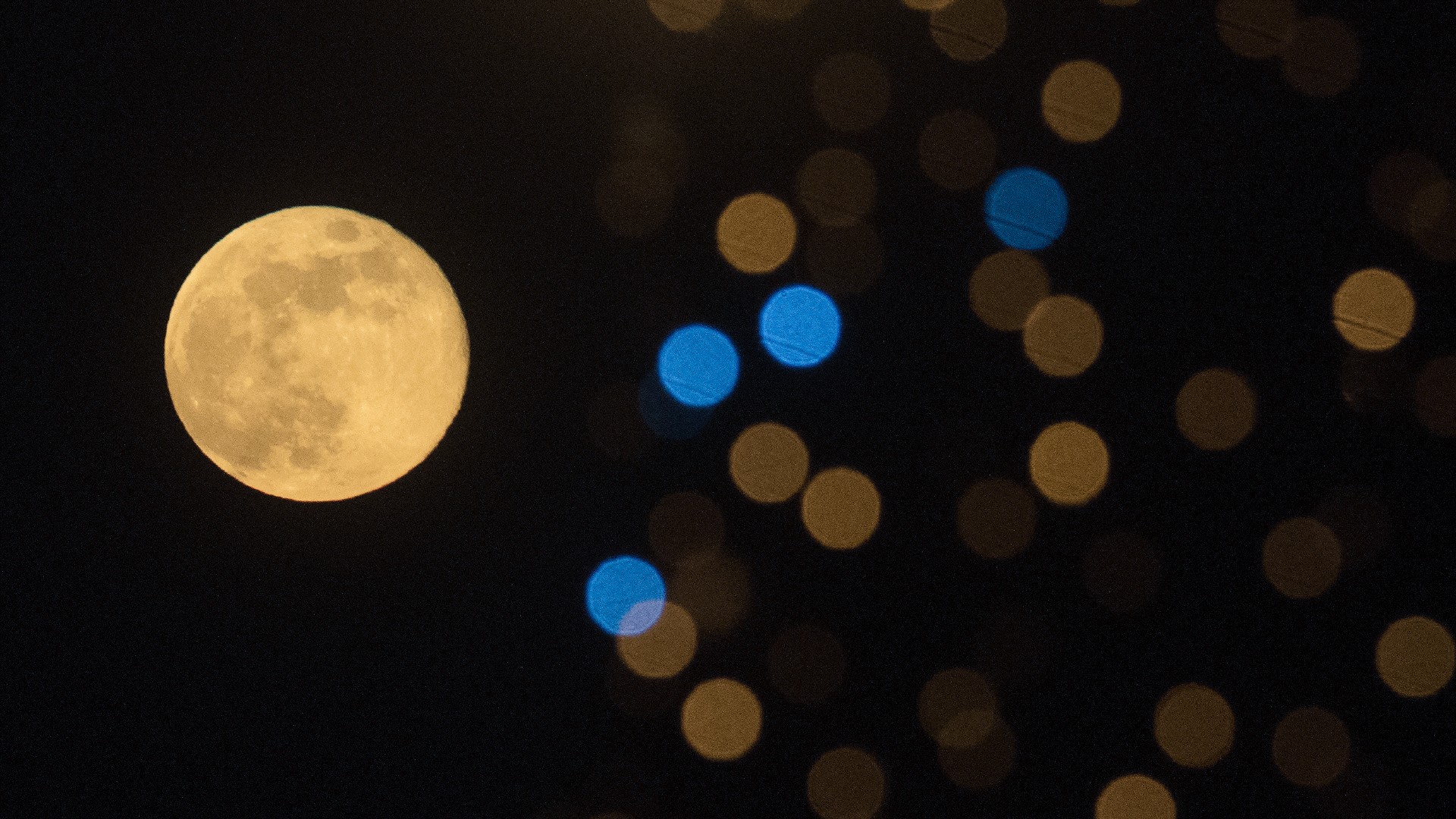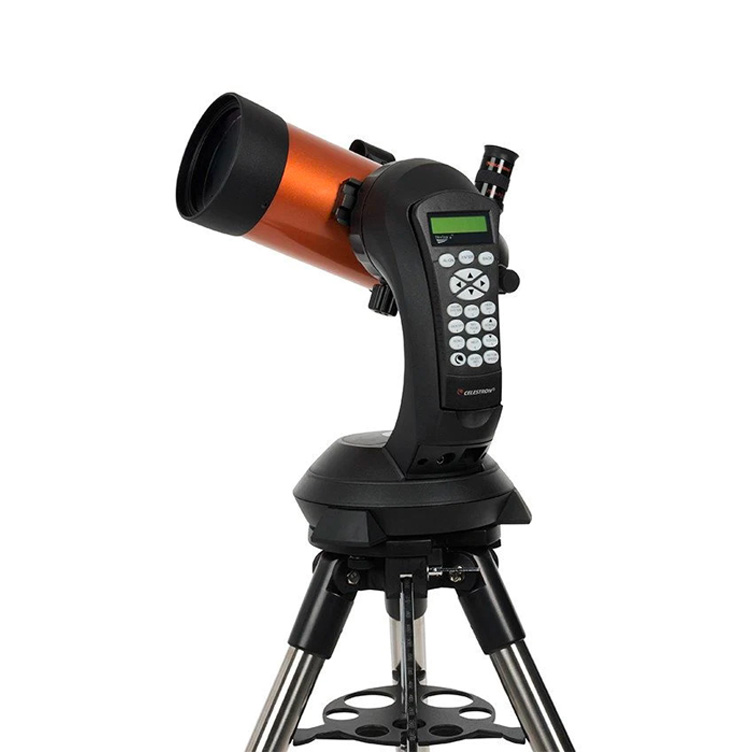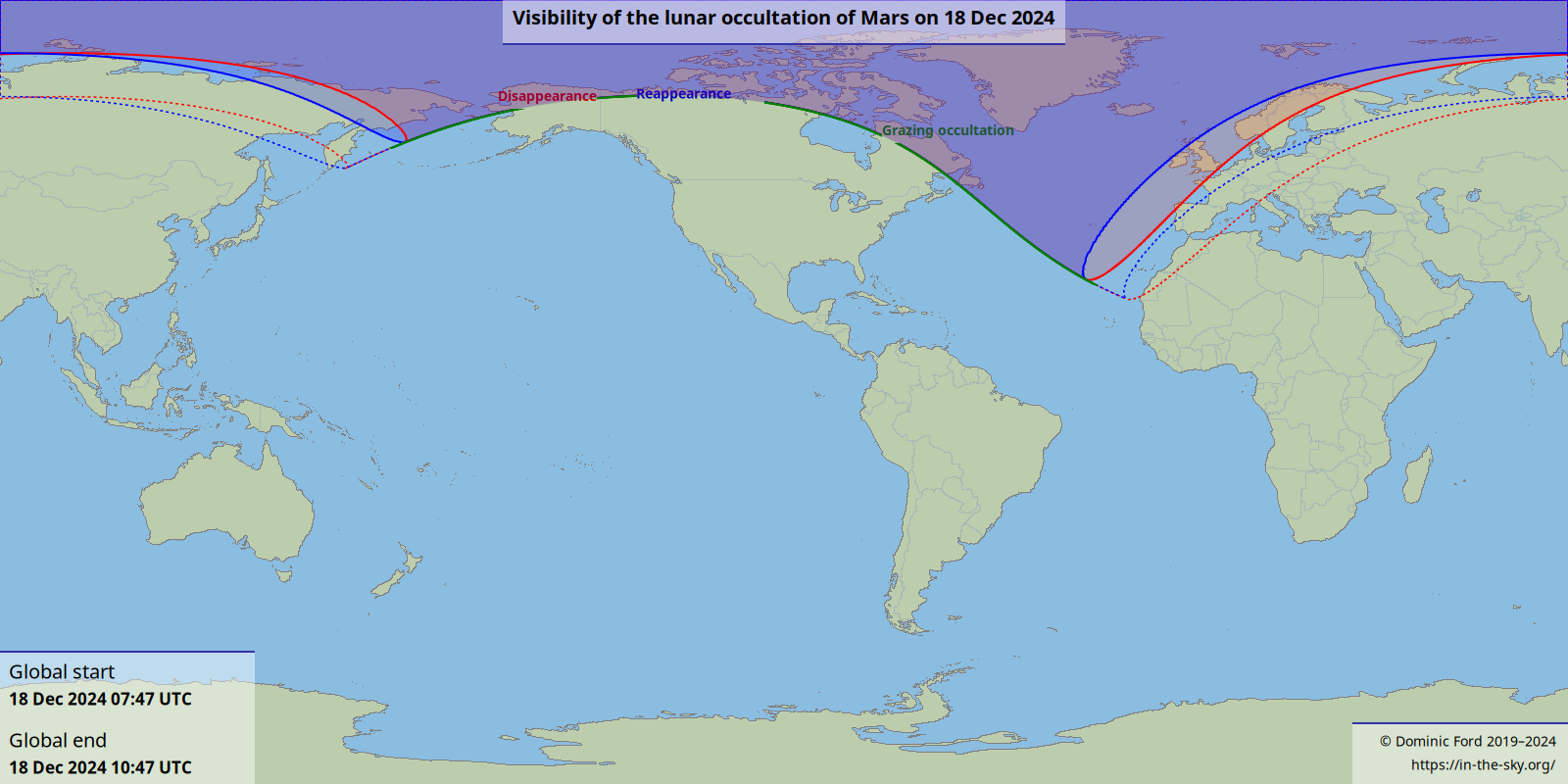
December's full moon, called the Cold Moon, falls on Dec. 15 at 4:02 a.m. Eastern Time (0902 UTC). For some observers in Central and South America it will occult the star Beta Tauri, the second-brightest star in Taurus, and three days later the moon will occult Mars.
For New York City observers, the moon will rise the evening of Dec. 14 at 3:33 p.m., according to the U.S. Naval Observatory, and set the next morning at 7:49 a.m. Sunrise on Dec. 15 is at 7:13 a.m. Eastern Time. The occultation of Beta Tauri, also called Elnath, won't be visible there, but at the moment of the occultation the moon will pass less than a degree from the star; by about 3:30 a.m. Eastern on Dec. 15, the moon will be about one lunar diameter to the left and just below (south) of Elnath.
Lunar occultations aren't visible from everywhere on Earth because the moon is close enough that one's position on Earth alters its position against the background stars. The change in the moon's apparent position can be up to two degrees; this affects both the latitude one can see occultations from and whether the moon will pass in front of the star or planet it is occulting while it is still above the horizon. This is the same reason solar eclipses are only visible along a narrow track, though occultations are visible over wider areas.

Want to see the features of the moon up close? The Celestron NexStar 4SE is ideal for beginners wanting quality, reliable and quick views of celestial objects. For a more in-depth look at our Celestron NexStar 4SE review.
Full moons, however, occur at the same time everywhere on Earth because the moon is considered full when it is on the opposite side of the Earth from the sun; the phase of the moon is independent of one's location on Earth. The specific hour the moon is full depends on one's time zone – for example the full moon occurs at 1:02 a.m. in Los Angeles, 10:02 a.m. in Paris, and 10:02 p.m. on Dec. 15 in Melbourne, Australia.
To see the moon pass in front of Elnath, one has to be in a band stretching from French Polynesia to the western coast of Mexico, Central America, Colombia, Ecuador, Peru, and Brazil and Chile.
At the western end of the region of visibility, in Papeete, Tahiti, the occultation starts at 7:27 p.m. local time on Dec. 14. according to In-the-sky.org. The moon, which rises at 6:20 p.m. local time, will be low in the northeast as Elnath disappears behind it. Elnath will reappear at 8:40 p.m. Because the moon appears to move eastwards against the background stars Elnath will look as though it is "overtaking" the moon as the pair climb into the sky.
In San Jose, Costa Rica, the occultation will start on Dec. 15 at 2:11 a.m. local time, and end at 2:47 a.m. The moon will be in the western sky, and Elnath will appear to be to the upper right quadrant of the moon's disk and emerge on the lower right.
From Lima, Peru, the moon will occult Elnath at 3:07 a.m. local time and the star will emerge at 4:18 a.m. Elnath will start in the upper right quadrant of the moon and come out from the lower left.
If you're looking to snap a photo of the December full moon, check out our guide on how to photograph the moon. If you don't have everything you need to photograph the night sky, consider our best cameras for astrophotography and best lenses for astrophotography.
Visible planets
On the night of the full moon, of the five naked-eye planets, four will be easily spotted starting at around 6 p.m. As the sun sets on Dec. 14, in the Northern Hemisphere's mid-latitudes, Venus will be bright in the western sky; from New York City it sets at 8:56 p.m. local time. Looking towards the south (leftwards) and higher, one will see Saturn, which sets at 10:25 p.m. The moon will still be low in the East, and nearby will be Jupiter, which will look as though it is level with the moon to the right. By about 9 p.m. one can look to the southeast and see the moon, Jupiter and Aldebaran, the brightest star in Taurus, the Bull, forming a line from left to right. Jupiter will set just before sunrise at 6:38 a.m. Mars rises at 7:30 p.m. and by 10 p.m. it will be about 26 degrees above the eastern horizon.
Mercury will be a harder target, though it rises in New York well before sunrise at 5:42 a.m. Eastern on Dec.15 it will still only be 8 degrees high by 6:30 a.m. and the sky will start to get light by then; civil twilight, when the sun is six degrees below the horizon, begins at 6:14 a.m.
Saturn, Jupiter and Mars will all be relatively high in the sky as the night progresses. Saturn will reach its maximum altitude, and cross the meridian (called transiting) first, at about 5:21 p.m. in New York, when it will be about 41 degrees high in the south. Jupiter follows at 11:15 p.m., and it will be at 71 degrees. Mars transits at 2:38 a.m. Dec. 15 and will reach 71 degrees above the southern horizon.
For Southern Hemisphere skywatchers the nights will be shorter, as it is summer there. In Melbourne, Australia, which is about as far south of the equator as Charlottesville, Virginia or Sacramento, California, sunset isn't until 8:38 p.m. Australian Eastern Daylight Time on Dec. 15. The almost-full moon rises at 8:56 p.m. in the northeast, and Venus will be in the northwest. Civil twilight ends at 9:10 p.m., and Venus will still be about 27 degrees high. The planet sets at 11:41 p.m.
As the sky darkens one will see Saturn above and to the east (right) of Venus about 44 degrees high in the west-northwest; Saturn sets at 1:13 a.m. on Dec. 16. In the Southern Hemisphere sky Jupiter is to the left of the moon, and appears slightly higher; in the early evening of Dec. 15, it is low in the northeast and by the time it transits at 12:37 a.m. Dec. 16, it is only about 30 degrees above the northern horizon. Mars rises at 11:27 p.m. and transits at 4:16 a.m., also reaching an altitude of about 30 degrees a bit more than an hour before sunrise at 5:21 a.m.
On Dec. 18, three days after the full moon, the moon occults Mars. This occultation will favor far northern locations in Canada, all of Greenland, Iceland, and northwestern Europe, according to the International Occultation Timing Association. In some places the occultation can be seen during the day, near moonrise or moonset. In daylight Mars can't be seen with the naked eye, but through a large pair of binoculars or small telescope one can use the moon as a target and look for Mars nearby.

It is, however, important to stress that without proper equipment it is very dangerous to use optical aids to look at the sky when the sun is above the horizon; exercise caution as even a moment's exposure to sunlight through a telescope can permanently damage one's eyes.
In Antwerp, Belgium, for example, the waning moon will be close to the horizon, only about 8 degrees high when Mars disappears behind it at 10:25 a.m. local time. The moon sets at 11:44 a.m., and Mars will not have emerged by then. In London, Mars goes behind the moon at 9:26 a.m. and reappears on the western side at 10:17 a.m., but the moon will only be about 4 degrees above the horizon and Mars will be difficult to see.
As one moves north and west the occultation completes before sunrise. In Reykjavik, Iceland, even though the occultation starts at 9:07 a.m., and ends at 10:03 a.m. the sun doesn't rise until 11:20 a.m. Mars will appear to "set" behind the moon on its eastern side, and reemerge on the western side. The moon will still be about 21 degrees above the horizon in the west.
In St. John's, Newfoundland, the occultation starts at 6:13 a.m., and Mars will appear to touch the moon's lower left side. The red planet emerges at 6:45 from the lower right side of the moon, which will be in shadow.
From location in the continental U.S. the moon will appear to make a close pass just above Mars, and as one moves south the apparent distance between the moon and Mars will increase.
Constellations
The moon rises in Taurus, one of the bright constellations that appears in the Northern Hemisphere winter. Surrounding the full moon one will be able to spot Auriga, Orion, and Gemini – hallmarks of the winter sky. By about 7:30 p.m. in New York (and other mid-northern latitude locations) the moon will be to the right of and below Capella, the brightest star in Auriga.
If one looks downwards from the moon one can see Betelgeuse, the bright reddish star that is Orion's right shoulder (the left shoulder from a stargazer's perspective) and to the right of it the three stars of Orion's Belt. Early in the evening they too will appear to be almost vertically lined up, though they assume a more horizontal appearance as the night goes on. The star closest to the horizon is Alnitak, the middle star of the belt is Alnilam, and the westernmost (highest) star is Mintaka. A full moon is so bright the fainter stars get washed out, but these groups of stars are bright enough that they can be seen if the sky is clear and without haze.
In the Southern Hemisphere, one sees the constellations "upside down" – as the moon rises one will see Orion above it rather than below. From Melbourne, Australia, by 10:30 p.m. the moon is still low in the northeast with Betelgeuse above and to the right of it, and Aldebaran above and to the left.
If one turns directly south one will see Alpha Centauri, also known as Rigil Kentaurus, which is circumpolar from Melbourne (and other locations further south than 29 degrees south in latitude). To the left of Alpha Centauri is Hadar, (Beta Centauri) and to the left of that is the Southern Cross. In the southeast about 51 degrees high is Canopus, the brightest star in Carina, the Ship's Keel.
December moon names
The Old Farmer's Almanac calls the December lunation the Cold Moon. The Old Farmer's Almanac names are taken from a combination of traditional European terms and those of the people they initially encountered in the Americas, who tended to be the northeastern Native peoples. Other groups had differing names: some Celtic peoples called the December lunation the Oak Moon,
In China, the December lunation is called Dōngyuè, "Winter Month" while in many Hindu lunar calendar systems the December lunation falls in the ninth month, and is called Agrahayana or Margashirsha in Sanskrit. In some calendrical systems in India the lunar month begins on the full moon, rather than the new moon.
In Jewish calendars the December full moon is in the midst of the month of Kislev; this is the month that Chanukah falls in (this year Chanukah will align with the week between Christmas and New Year's Eve). In the Islamic Calendar the full moon falls on the 14th day of Jumada al Thani, the sixth month of the year; unlike the Hebrew calendar Islamic calendars do not use an intercalary month to keep the months in step with the seasons.
Editor's note: If you snap a great photo of the Cold Moon or any other night sky sight you'd like to share with Space.com and our news partners for a story or image gallery, send images and comments to spacephotos@space.com.







